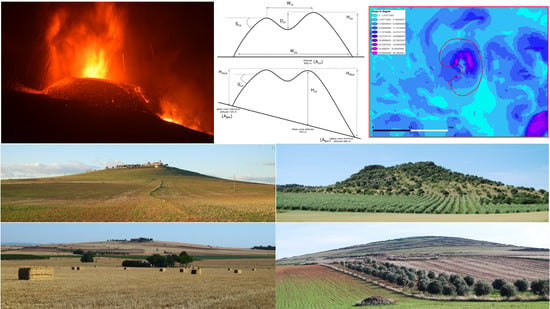Morphometric Analysis of Scoria Cones to Define the ‘Volcano-Type’ of the Campo de Calatrava Volcanic Region (Central Spain)
Abstract
1. Introduction
2. Study Area: Geographical and Geological Setting in the Campo de Calatrava Volcanic Region
3. Materials and Methods
- Cone height (Hco), calculated as the difference between the altitude of the top of the cone and the altitude of the base of the cone [3,4,5,7,12,14,21,23,26,27,29,30] for cones located in areas with flat topography (Figure 4). To calculate the height of cones located in areas with pronounced slopes where the base is at different altitudes (stratovolcanoes and volcanic rifts) or in mountain and piedmont areas (as in Campo de Calatrava), a method proposed by other authors was used [10,36,45] whereby the height is the difference between the altitude of the summit and the mean altitude of the volcano (Figure 5), calculated from the arithmetic mean of the altitudinal values of the base of the cone (minimum and maximum altitude) (Equation (1)) or of the maximum and minimum heights of the cone relative to the base (Equation (2)) [44].Hco = ½ [(Aco − ABm) + (Aco − ABM)]where Aco is the altitude of the top of the cone, ABM is the maximum altitude of the base of the cone, ABm is the minimum altitude of the base, HMco is the maximum cone height, and Hmco is the minimum cone height.Hco = ½ (HMco − Hmco)
- Cone diameters, maximum (WMco), minimum (Wmco), and mean (or cone width Wco). These are calculated by comparing the volcano with a circumference or an ellipse, where the axes of the ellipse are the basal diameters of the volcanic edifice (Figure 6). To calculate the mean cone diameter (Wco), the arithmetic mean of the largest (WMco) and smallest (Wmco) diameters of the volcanic edifice is calculated using methods drawn from other authors [3,4,5,7,9,12,14,19,21,23,26,27,29,30].
- Cone volume (Vco). Different formulae are used to calculate this parameter depending on whether or not the volcanic edifice still has a crater. Other morphometric parameters such as height, mean basal diameter and radius of the cone, and diameter and radius of the crater are also used.If the cone has no crater, the formula used to calculate the volume is the same as for the calculation of the volume of the geometric shape of an oblique cone. If the cone still has a crater, the geometric formula for calculating the volume of a truncated cone is used [9,10,12,23,27]. Volume is given in km3 in line with the unit of measurement used in the international literature.Vco with crater = 1/3 {π Hco [(Rco2 + rcr2) + (Rco × rcr)]}where Hco is the cone height, Rco is the radius of the cone base (calculated as the half of the cone diameter = Wco/2), rcr is the radius of the cone crater (calculated as the half of the crater diameter = Wcr/2).Vco without crater = 1/3 [π Hco × Rco2]
- Cone maximum slope (Smaxco) corresponds to the maximum gradient in degrees from the highest point of the cone to its base [5,12,16,20,23,26,27,34,36,42]. These measurements were taken by generating a slope raster file from the DEM using the ArcMap Slope tool (Figure 7) [44]. The silhouette of the cone was superimposed on the slope raster and the steepest slope was then determined.
- Cone slope (Sco), is the average slope of the entire surface of the volcanic edifice obtained by calculating the value of the α angle on the triangle outlined by the height and length of the volcano with respect to the horizontal line. It may be obtained from two methods: by using the cone to form a right-angled triangle and calculating the slope in degrees of one of its sides [8,44]; or by the method proposed by Hasenaka and Carmichael [12,27] and other authors [7,14,15,24,34,37,77,78]. It is calculated using the following equations:Sco without crater = tan−1 [2Hco/Wco]where Hco is the cone height, Wco is the mean cone diameter and Wcr is the mean crater diameter.Sco with crater = tan−1 [2Hco/(Wco − Wcr)]
- Cone elongation (Eco) and crater elongation (Ecr). The ratio of the greatest to the smallest cone/crater diameter is calculated to determine whether or not the volcanic eruption that produced the volcanic edifice was a fissure eruption. According to Dóniz-Páez [8], the closer the value is to 1, the more rounded the cone will be; and the further away from 1, the more elongated it will be, especially for values higher than 1.5 [2,12,24,27,76,79,80,81].
- Separation index between cones (SIco). Calculation of the distance between two volcanic edifices in close proximity to each other (Figure 8) from the distance measured from the geometric center of a cone to the geometric center of the nearest cone [3,5,7,12,27]. The calculations were performed through spatial analysis using the Proximity toolset in the ArcMap ArcToolbox package to generate and analyze distances between two points.
4. Results and Discussion
4.1. Morphometric Analysis
- they are old volcanoes (most of the dated volcanoes are older than 2.5 My [48,50,56,60]), and their forms are half-buried by sedimentary deposits in the Neogene basins or in the mountain ranges and piedmont by hillslope colluvium and other deposits [44], which makes it very difficult to correctly identify and analyze them morphometrically, as it happens in other volcanic fields [42];
- they exhibit significant degradation as a result of extreme anthropogenic pressure (mining and extractive activity) on some cones, which has caused them to all but disappear, consequently making it impossible to measure morphometric parameters and to establish a morphological classification.
| Mean | Typical Error | Median | Mode | Standard Deviation | Minimum | Maximum | Counting * | |
|---|---|---|---|---|---|---|---|---|
| Scoria cones | ||||||||
| Hco | 36.54 | 2.02 | 33.00 | 17.00 | 21.54 | 10.00 | 108.00 | 114 |
| Aco | 0.454 | 0.043 | 0.327 | 0.162 | 0.455 | 0.027 | 2.856 | 114 |
| Vco | 0.008113 | 0.001099 | 0.002937 | - | 0.011734 | 0.000142 | 0.055293 | 114 114 |
| WMco | 737.71 | 32.02 | 681.50 | 514.00 | 341.93 | 229.00 | 2004.00 | 114 |
| Wmco | 612.18 | 30.82 | 572.00 | 336.00 | 329.10 | 132.00 | 1887.00 | 114 |
| Wco | 674.94 | 31.10 | 626.25 | 706.50 | 332.06 | 193.00 | 1945.50 | 114 |
| Ncr | 1.17 | 0.06 | 1.00 | 1.00 | 0.38 | 1.00 | 2.00 | 47 |
| WMcr | 218.47 | 19.96 | 181.00 | 126.00 | 136.83 | 38 | 618 | 47 |
| Wmcr | 158.00 | 15.46 | 142.00 | 142.00 | 105.95 | 26.00 | 487.00 | 47 |
| Wcr | 188.23 | 17.24 | 163.50 | 93.00 | 118.17 | 32.00 | 521.50 | 47 |
| Dcr | 23.79 | 2.95 | 20.00 | 5.00 | 20.22 | 2.00 | 80.00 | 47 |
| Smaxco | 15.85 | 0.69 | 14.00 | 10.00 | 7.34 | 5.00 | 40.00 | 114 |
| Sco | 6.79 | 0.33 | 6.11 | - | 3.56 | 1.72 | 16.57 | 114 |
| Eco | 1.27 | 0.02 | 1.20 | 1.26 | 0.23 | 1.00 | 1.99 | 114 |
| Ecr | 1.94 | 0.09 | 1.30 | - | 0.63 | 1.01 | 4.48 | 47 |
| SIco | 2410.24 | 163.09 | 1990.00 | 1440.00 | 1741.38 | 375.00 | 9323.00 | 114 |
| Spatter cones | ||||||||
| Hco | 11.54 | 1.00 | 10.00 | 10.00 | 4.90 | 4.00 | 24.00 | 24 |
| Aco | 0.097 | 0.019 | 0.060 | 0.035 | 0.094 | 0.007 | 0.334 | 24 |
| Vco | 0.000340 | 0.000074 | 0.000232 | - | 0.000362 | 0.000019 | 0.001563 | 24 24 |
| WMco | 362.67 | 40.09 | 292.00 | - | 196.42 | 107 | 766 | 24 |
| Wmco | 259.75 | 28.34 | 217.50 | - | 138.82 | 98 | 556 | 24 |
| Wco | 311.21 | 33.16 | 261.75 | - | 162.46 | 102.50 | 634.00 | 24 |
| Ncr | 1.00 | 0 | 1.00 | 1.00 | 0 | 1.00 | 1.00 | 2 |
| WMcr | 41.00 | 39.00 | 41.00 | - | 55.15 | 2.00 | 80.00 | 2 |
| Wmcr | 28.00 | 26.00 | 28.00 | - | 36.77 | 2 | 54 | 2 |
| Wcr | 34.50 | 32.50 | 34.50 | - | 45.96 | 2.00 | 67.00 | 2 |
| Dcr | 2.50 | 1.50 | 2.50 | - | 2.12 | 1.00 | 4.00 | 2 |
| Smaxco | 12.21 | 1.47 | 11.50 | 16.00 | 7.21 | 3.00 | 30.00 | 24 |
| Sco | 5.53 | 0.71 | 5,25 | - | 3.46 | 0.90 | 14.87 | 24 |
| Eco | 1.41 | 0.08 | 1.30 | - | 0.37 | 1.06 | 2.78 | 24 |
| Ecr | 1.24 | 0.24 | 1.24 | - | 0.34 | 1.00 | 1.48 | 2 |
| SIco | 2290.38 | 374.03 | 1587.00 | 1389.00 | 1832.35 | 375.00 | 8132.00 | 24 |
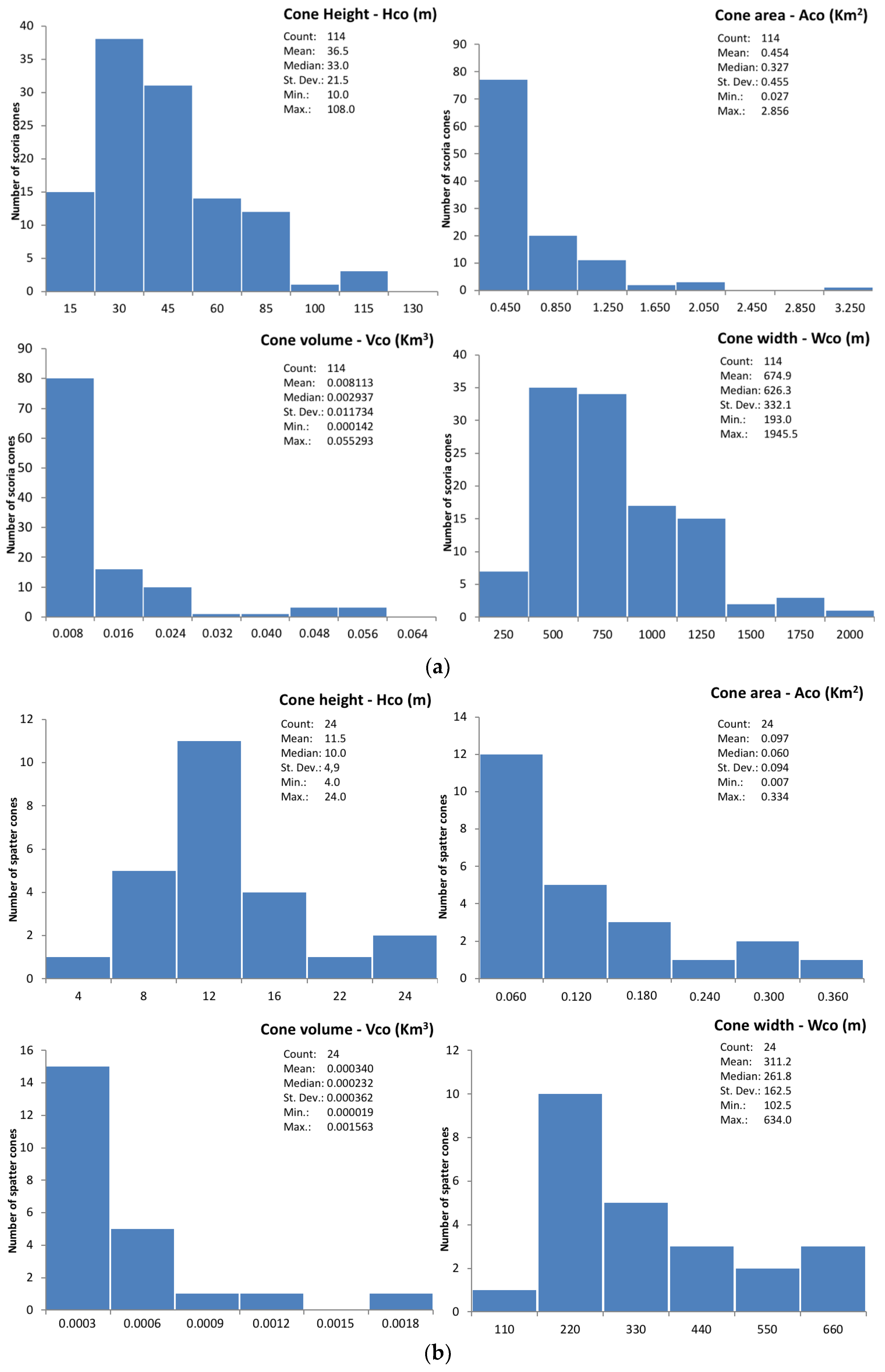
- Component 1—Size: the nine parameters that offer the strongest correlations (>0.80 and height 0.608) are closely related to the description of the size of volcanic cones—namely height, area, and volume—and the dimensions of the cone base and craters which, to some extent, are also related to the dimensions of the volcanic edifice.
- Component 2—Steepness: the three parameters that give the best results are those related to the maximum and average slope and height of the cone, so this component explains the steepness of the cone and, to a certain extent, its relationship with the erosion of the volcano.
- Component 3—Craters: only the number of craters variable gives a strong correlation.
- Component 4—Crater shape: only the crater elongation parameter shows a strong correlation.
4.2. Defining the ‘Volcano-Type’ of Campo de Calatrava Volcanic Region
5. General Discussion
6. Final Remarks
- Analyze eruptive complexes where several overlapping landforms occur (scoria cones, spatter cones, maar), produced by eruptive pulses of different kinds, to determine whether there are other ‘volcano-types’;
- Model the morphological evolution of these volcanoes within the landscape, as part of the natural heritage (geoheritage/geomorphological heritage);
- Include these qualitative and quantitative analyses in the study of the geoheritage and landscape heritage of the Calatrava volcanoes, with a view to their being designated as a UNESCO global geopark. Even more so in a project within a region where the leading attraction is the volcanoes, their morphological imprint on the landscape, the natural resources they offer (fertile soils, hot springs, ecosystems), the use they have been put to throughout history (mining, agriculture, geotourism and volcano tourism), and their sustainable management (geoconservation and protection);
- Develop sustainable management tools for the region covered by this project, taking into account the most representative and best-preserved volcanic landforms.
Author Contributions
Funding
Institutional Review Board Statement
Informed Consent Statement
Acknowledgments
Conflicts of Interest
References
- McDonald, G.A. Volcanoes; Prentice-Hall: Englewood Cliffs, NJ, USA, 1972. [Google Scholar]
- Pike, R.J. Volcanoes on the inner planets: Some preliminary comparisons of gross topography. In Proceedings of the Lunar and Planetary Science Conference, 9th, Houston, TX, USA, 13–17 March 1978; Pergamon Press Inc.: New York, NY, USA, 1978; Volume 3, pp. 3239–3273. [Google Scholar]
- Settle, M. The structure and emplacement of cinder cone fields. Am. J. Sci. 1979, 279, 1089–1107. [Google Scholar] [CrossRef]
- Wood, C.A. Morphometric evolution of cinder cones. J. Volcanol. Geotherm. Res. 1980, 7, 387–413. [Google Scholar] [CrossRef]
- Wood, C.A. Morphometric analysis of cinder cone degradation. J. Volcanol. Geotherm. Res. 1980, 8, 137–160. [Google Scholar] [CrossRef]
- Sigurdsson, H.; Houghton, B.; McNutt, S.; Rymer, H. (Eds.) Encyclopedia of Volcanoes; Academic Press: San Diego, CA, USA, 2000. [Google Scholar]
- Inbar, M.; Risso, C. A morphological and morphometric analysis of high cinder cone volcanic field–Payun Matru, south-central Andes, Argentina. Z. Für Geomorphol. 2001, 45, 321–344. [Google Scholar] [CrossRef]
- Dóniz-Páez, J. Caracterización Geomorfológica del Volcanismo Basáltico Monogénico de la Isla de Tenerife. Ph.D. Thesis, Universidad de La Laguna, Tenerife, Spain, 2004. [Google Scholar]
- Dóniz, J.; Romero, C.; Coello, E.; Guillen, C.; Sánchez, N.; García-Cacho, L.; García, A. Morphological and statistical characterisation of recent mafic volcanism on Tenerife (Canary Islands, Spain). J. Volcanol. Geotherm. Res. 2008, 173, 185–195. [Google Scholar] [CrossRef]
- Dóniz-Páez, J.; Romero, C.; Sánchez, N. Quantitative size classification of scoria cones: The case of Tenerife (Canary Islands, Spain). Phys. Geogr. 2013, 33, 514–535. [Google Scholar] [CrossRef]
- Németh, K.; Kereszturi, G. Monogenetic volcanism: Personal views and discussion. Int. J. Earth Sci. (Geol. Rundsch.) 2015, 104, 2131–2146. [Google Scholar] [CrossRef]
- Hasenaka, T.; Carmichael, I. The cinder cones of Michoacán-Guanajato, central Mexico: Their age, volume, distribution and magma discharge rate. J. Volcanol. Geotherm. Res. 1985, 25, 105–124. [Google Scholar] [CrossRef]
- Cas, R.A.F.; Wright, J.V. Volcanic Successions, Modern and Ancient; Chapman & Hall: London, UK, 1987. [Google Scholar]
- Hooper, D.; Sheridan, M. Computer-simulation models of scoria cone degradation. J. Volcanol. Geotherm. Res. 1998, 83, 241–267. [Google Scholar] [CrossRef]
- Martens, U. Aspectos morfométricos de los conos de escoria de Costa Rica. Rev. Geológica De América Cent. 2004, 30, 15–29. [Google Scholar] [CrossRef][Green Version]
- Kereszturi, G.; Németh, K. Monogenetic Basaltic Volcanoes: Genetic Classification, Growth, Geomorphology and Degradation. In Updates in Volcanology. New Advances in Understanding Volcanic Systems; Németh, K., Ed.; IntechOpen: London, UK, 2012; pp. 3–89. [Google Scholar]
- Vesperman, D.; Schmincke, H.U. Scoria cones and tuff rings. In Encyclopedia of Volcanoes; Sigurdsson, H., Houghton, B.F., McNutt, S.R., Reymer, H., Stix, J., Eds.; Academic Press: San Diego, CA, USA, 2000; pp. 683–694. [Google Scholar]
- Walker, G.P.L. Basaltic volcanoes and volcanic systems. In Encyclopedia of Volcanoes; Sigurdsson, H., Houghton, B.F., McNutt, S.R., Reymer, H., Stix, J., Eds.; Academic Press: San Diego, CA, USA, 2000; pp. 283–289. [Google Scholar]
- Kereszturi, G.; Németh, K. Structural and morphometric irregularities of eroded Pliocene scoria cones at the Bakony-Balaton Highland Volcanic Field, Hungary. Geomorphology 2012, 136, 45–58. [Google Scholar] [CrossRef]
- Kereszturi, G.; Jordan, G.; Németh, K.; Dóniz-Páez, J. Syn-eruptive morphometric variability of monogenetic scoria cones. Bull. Volcanol. 2012, 74, 2171–2185. [Google Scholar] [CrossRef]
- Dohrenwed, J.; Wells, S.; Turrin, B. Degradation of Quaternary cinder cones in the Cima volcanic field, Mojave Desert, California. Geol. Soc. Am. Bull. 1986, 97, 421–427. [Google Scholar] [CrossRef]
- Hooper, D. Computer-simulation models of scoria cone degradation in the Colima and Michoacán–Guanajuato volcanic fields, Mexico. Geofísica Int. 1995, 34, 321–340. [Google Scholar]
- Carn, S.A. The Lamongan volcanic field, East Java, Indonesia: Physical volcanology, historic activity and hazards. J. Volcanol. Geotherm. Res. 2000, 95, 81–108. [Google Scholar] [CrossRef]
- Corazzato, C.; Tibaldi, A. Fracture control on type, morphology and distribution of parasitic volcanic cones: An example from Mt. Etna, Italy. J. Volcanol. Geotherm. Res. 2006, 158, 177–194. [Google Scholar] [CrossRef]
- Tibaldi, A. Morphology of pyroclastic cones and tectonics. J. Geophys. Res. 1995, 100, 24521–24535. [Google Scholar] [CrossRef]
- Porter, S. Distribution, morphology, and size frequency of cinder cones on Mauna Kea volcano, Hawaii. Geol. Soc. Am. Bull. 1972, 83, 3607–3612. [Google Scholar] [CrossRef]
- Hasenaka, T.; Carmichael, I. A compilation of location, size and geomorphological parameters of volcanoes of Michoacán–Guanajato Volcanic Field, Central Mexico. Geofísica Int. 1985, 24, 577–607. [Google Scholar]
- Márquez, A.; Verma, S.; Anguita, F.; Oyarzun, R.; Brandle, J. Tectonics and volcanism of Sierra Chichinautzin: Extension at the front of the Central Trans-Mexican Volcanic Belt. J. Volcanol. Geotherm. Res. 1999, 93, 125–150. [Google Scholar] [CrossRef]
- Martín del Pozzo, A. Monogenetic volcanism in Sierra Chichinautzin, Mexico. Bull. Volcanol. 1982, 45, 9–24. [Google Scholar] [CrossRef]
- Karátson, D. Rates and factors of stratovolcano degradation in a continental climate: A complex morphometric analysis for nineteen Neogene/Quaternary crater remnants in the Carphatians. J. Volcanol. Geotherm. Res. 1996, 73, 65–78. [Google Scholar] [CrossRef]
- Fornaciai, A.; Behncke, B.; Favalli, M.; Neri, M.; Tarquini, S.; Boschi, E. Detecting short-term evolution of Etnean cinder cones: A LIDAR-based approach. Bull. Volcanol. 2010, 72, 1209–1222. [Google Scholar] [CrossRef]
- Romero, C. El Relieve de Lanzarote; Cabildo de Lanzarote: Tenerife, Spain, 2003. [Google Scholar]
- Uslular, G.; Le Corvec, N.; Mazzarini, F.; Legrand, D.; Gençalioğlu-Kuşcu, G. Morphological and multivariate statistical analysis of quaternary monogenetic vents in the Central Anatolian Volcanic Province (Turkey): Implications for the volcano-tectonic evolution. J. Volcanol. Geotherm. Res. 2021, 416, 107280. [Google Scholar] [CrossRef]
- Hasenaka, T. Size, distribution and magma output rate for shield volcanoes of the Michoacán-Guanajato volcanic field, Central Mexico. J. Volcanol. Geotherm. Res. 1994, 63, 13–31. [Google Scholar] [CrossRef]
- Karátson, D. Erosion of primary volcanic depressions in the Inner Carpathian Volcanic Chain. Z. Für Geomorphol. Suppl. 1999, 114, 46–62. [Google Scholar]
- Favalli, M.; Karátson, D.; Mazzarini, F.; Pareschi, M.T.; Boschi, E. Morphometry of scoria cones located on a volcano flank: A case study from Mt. Etna (Italy), based on high-resolution LiDAR data. J. Volcnaology Geotherm. Res. 2009, 186, 320–330. [Google Scholar] [CrossRef]
- Inbar, M.; Gilichinsky, M.; Melekestev, I.; Melnikov, D.; Zaretskaya, N. Morphometric and morphological development of Holocene cinder cones: A field and remote sensing study in the Tolbachik volcanic field, Kamchatka. J. Volcanol. Geotherm. Res. 2011, 201, 301–311. [Google Scholar] [CrossRef]
- Kereszturi, G.; Németh, K. Shallow-seated controls on the evolution of the Upper Pliocen Kopasz-hegy nested monogenetic volcanic chain in the Western Pannonian Basin (Hungary). Geol. Carpathica 2011, 62–66, 535–546. [Google Scholar] [CrossRef]
- Fornaciai, A.; Favalli, M.; Karátson, D.; Tarquini, S.; Boschi, E. Morphometry of scoria cones, and their relation to geodynamic setting: A DEM-based analysis. J. Volcanol. Geotherm. Res. 2012, 217–218, 56–72. [Google Scholar] [CrossRef]
- Grosse, P.; Ochi, M.L.; Escalante, F.; Guzmán, S.; Orihashi, Y.; Sumino, H. Geomorphology, morphometry, spatial distribution and ages of mafic monogenetic volcanoes of the Peinado and Incahuasi fields, southernmost Central Volcanic Zone of the Andes. J. Volcanol. Geotherm. Res. 2020, 401, 106966. [Google Scholar] [CrossRef]
- Vörös, F.; van Wyk de Vries, B.; Karátson, D.; Székely, B. DTM-Based Morphometric Analysis of Scoria Cones of the Chaîne des Puys (France)—The Classic and a New Approach. Remote Sens. 2021, 13, 1983. [Google Scholar] [CrossRef]
- Aguilera, M.; Ureta, G.; Grosse, P.; Németh, K.; Aguilera, F.; Vilches, M. Geomorphological, morphometric, and spatial distribution analysis of the scoria cones in the Negros de Aras monogenetic volcanic field, northern Chile. J. Volcanol. Geotherm. Res. 2022, 422, 107458. [Google Scholar] [CrossRef]
- Gosálvez, R.U. Análisis Biogeográfico de las Lagunas Volcánicas de la Península Ibérica. Ph.D. Thesis, UCLM, Ciudad Real, Spain, 2011. Available online: http://hdl.handle.net/10578/3246 (accessed on 20 March 2022).
- Becerra-Ramírez, R. Geomorfología y Geopatrimonio de los Volcanes Magmáticos de la Región Volcánica del Campo de Calatrava. Ph.D. Thesis, UCLM, Ciudad Real, Spain, 2013. Available online: http://hdl.handle.net/10578/3606 (accessed on 24 March 2022).
- Dóniz-Páez, J. Volcanic geomorphological classification of the cinder cones of Tenerife (Canary, Islands, Spain). Geomorphology 2015, 228, 432–447. [Google Scholar] [CrossRef]
- Vörös, F.; Pál, M.; van Wyk de Vries, B.; Székely, B. Development of a New Type of Geodiversity System for the Scoria Cones of the Chaîne des Puys Based on Geomorphometric Studies. Geosciences 2021, 11, 58. [Google Scholar] [CrossRef]
- Cartografía Geocientífica. Spanish Geological Survey (IGME). Available online: http://www.igme.es/actividadesIGME/lineas/cartoGeo.htm (accessed on 24 March 2022).
- Ancochea, E. Evolución Espacial y Temporal del Volcanismo Reciente de España Central. Ph.D. Thesis, UCM, Madrid, Spain, 1983. [Google Scholar]
- López-Ruiz, J.; Cebriá, J.M.; Doblas, M.; Oyarzum, R.; Hoyos, M.; Martín, C. Cenozoic intra-plate volcanism related to extensional tectonics at Calatrava, central Iberia. Geol. Soc. 1993, 150, 915–922. [Google Scholar] [CrossRef]
- Poblete, M.A. El Relieve Volcánico del Campo de Calatrava (Ciudad Real); University of Oviedo and JCCM: Oviedo, Spain, 1995. [Google Scholar]
- Becerra-Ramírez, R.; Gosálvez, R.U.; Escobar, E.; González, E.; Serrano-Patón, M.; Guevara, D. Characterization and Geotourist Resources of the Campo de Calatrava Volcanic Region (Ciudad Real, Castilla-La Mancha, Spain) to Develop a UNESCO Global Geopark Project. Geosciences 2020, 10, 441. [Google Scholar] [CrossRef]
- García, J.L. Mapa Geomorfológico de la Comarca de Los Montes-Campo de Calatrava: E: 1:200,000; UCLM: Madrid, Spain, 1994. [Google Scholar]
- Cebriá, J.M.; López Ruíz, J. Alkali basalts and leucitites in an extensional intracontinental plate setting: The late Cenozoic Calatrava Volcanic Province (Central Spain). Lithos 1995, 35, 27–46. [Google Scholar] [CrossRef]
- Cebriá, J.M.; López Ruíz, J. A refined method for trace element modelling of nonmodal batch partial melting processes: The Cenozoic continental volcanism of Calatrava, Central Spain. Geochim. Cosmochim. Acta 1996, 60, 1355–1366. [Google Scholar] [CrossRef]
- García Serrano, J.; Villaseca, C.; Pérez-Soba, C. Depleted lherzolite xenoliths from the leucititic Morrón de Villamayor volcano (Calatrava volcanic field, Spain). Lithos 2021, 380–381, 105830. [Google Scholar] [CrossRef]
- Ancochea, E.; Huertas, M.J. Radiometric ages and time–space distribution of volcanism in the Campo de Calatrava Volcanic Field (Iberian Peninsula). J. Iber. Geol. 2021, 47, 209–223. [Google Scholar] [CrossRef]
- González, E.; Gosálvez, R.; Becerra-Ramírez, R.; Escobar, E. Condiciones Medioambientales en el Holoceno Medio del Campo de Calatrava Oriental (Ciudad Real, España): Resultados Preliminares; Actas del IX Congreso Nacional de Biogeografía: Ávila, Spain, 2006. [Google Scholar]
- González, E.; Gosálvez, R.; Becerra-Ramírez, R.; Escobar, E. Actividad eruptiva holocena en el Campo de Calatrava (Volcán Columba, Ciudad Real, España). In Contribuciones al Estudio del Período Cuaternario; Lario, J., Silva, G., Eds.; Aequa: Ávila, Spain, 2007; pp. 143–144. [Google Scholar]
- Poblete, M.A.; Ruíz, J. Revisión de la edad del volcanismo en la región volcánica central de España: Evidencias geomorfológicas de actividad volcánica cuaternaria. In Contribuciones al Estudio del Período Cuaternario; Lario, J., Silva, G., Eds.; Aequa: Ávila, Spain, 2007; pp. 163–164. [Google Scholar]
- Poblete, M.A.; Martí, J.; Beato, S.; Marino, J.L. Geomorphological evolution and chronology of the eruptive activity of the Columba and Cuevas Negras volcanoes (Campo de Calatrava Volcanic Field, Ciudad Real, Central Spain). Geomorphology 2019, 336, 52–64. [Google Scholar] [CrossRef]
- Calatrava Volcanic Field. Global Volcanism Program. National Museum of Natural History, Smithsonian Institution (USA). Available online: https://volcano.si.edu/volcano.cfm?vn=210040 (accessed on 7 April 2022).
- Calvo, D.; Barrancos, J.; Padilla, G.; Brito, M.; Becerra-Ramírez, R.; Gosálvez, R.; González, E.; Escobar, E.; Melián, G.; Nolasco, D.; et al. Emisión difusa de CO2 en el Campo de Calatrava. In Aportaciones Recientes en Volcanología, 2005–2008; González, E., Escobar, E., Becerra-Ramírez, R., Gosálvez, R., Dóniz, J., Eds.; Centro de Estudios Calatravos: Ciudad Real, Spain, 2010; pp. 51–52. [Google Scholar]
- Elío, J.; Ortega, M.F.; Nisi, B.; Mazadiego, L.F.; Vaselli, O.; Caballero, J.; Grandi, F. CO2 and Rn degassing from the natural analog of Campo de Calatrava (Spain): Implications for monitoring of CO2 storage sites. Int. J. Greenh. Gas Control 2015, 32, 1–14. [Google Scholar] [CrossRef]
- Nisi, B.; Vaselli, O.; Elio, J.; Giannini, L.; Tassi, F.; Guidi, M.; Darrah, M.; Maletic, E.L.; Delgado, A.; Marchionni, S. The Campo de Calatrava Volcanic Field (central Spain): Fluid geochemistry in a CO2-rich area. Appl. Geochem. 2019, 102, 153–170. [Google Scholar] [CrossRef]
- Poblete Piedrabuena, M.A.; Beato, S.; Marino, J.L. Landforms in the Campo de Calatrava Volcanic Field (Ciudad Real, Central Spain). J. Maps 2016, 12 (Suppl. 1), 271–279. [Google Scholar] [CrossRef]
- Araña, V.; Aparicio, A.; Martín Escorza, C.; García Cacho, L.; Ortíz, R.; Vaquer, R.; Barberi, F.; Ferrara, G.; Albert, J.; Gassiot, X. El volcanismo neógeno-cuaternario de Catalunya: Caracteres estructurales, petrológicos y geodinámicos. In Acta Geològica Hispànica; Consejo Superior de Instigaciones Cientificas (CSIC): Madrid, Spain, 1983; Volume 18, 1, pp. 16–17. Available online: http://hdl.handle.net/10261/7023 (accessed on 7 April 2022).
- Mazzarini, F.; Armienti, P. Flank cones at Mount Etna Volcano: Do they have a power-law distribution? Bull. Volcanol. 2001, 62, 420–430. [Google Scholar] [CrossRef]
- Dóniz-Páez, J. Los campos volcánicos monogénicos de la isla de Tenerife (Canarias, España). Estud. Geográficos 2005, 66, 461–480. [Google Scholar] [CrossRef][Green Version]
- Thouret, J.C. Volcanic geomorphology, an overview. Earth Sci. Rev. 1999, 47, 95–131. [Google Scholar] [CrossRef]
- Lanza Digital, 2 July 2019. Available online: https://www.lanzadigital.com/provincia/la-diputacion-impulsa-la-creacion-de-un-geoparque-que-aglutine-los-complejos-volcanicos-de-la-provincia/ (accessed on 11 March 2022).
- Europa Press, 7 December 2020. Available online: https://www.europapress.es/castilla-lamancha/noticia-diputacion-crea-comite-cientifico-unesco-reconozca-posibilidades-geoparque-volcanes-calatrava-20200711105802.html (accessed on 11 March 2022).
- Proyecto de Geoparque Volcanes de Calatrava. Ciudad Real. Available online: https://www.proyectogeoparquevolcanesdecalatrava.es/ (accessed on 1 April 2022).
- Centro Nacional de Información Geográfica. Centro de Descargas. Available online: https://centrodedescargas.cnig.es/CentroDescargas/index.jsp (accessed on 22 February 2022).
- Bloomfield, K. A late-Quaternary monogenetic volcano field in central Mexico. Geol. Rundsch. 1975, 64, 476–497. [Google Scholar] [CrossRef]
- Rodríguez-González, A.; Fernández-Turiel, J.L.; Pérez-Torrado, F.J.; Aulinas, M.; Carracedo, J.C.; Gimeno, D.; París, R. GIS methods applied to the degradation of monogenetic volcanic fields: A case study of the Holocene volcanism of Gran Canaria (Canary Islands, Spain). Geomorphology 2011, 134, 249–259. [Google Scholar] [CrossRef]
- Kervyn, M.; Ernst, G.G.J.; Carracedo, J.C.; Jacobs, P. Geomorphometric variability of ‘monogenetic’ volcanic cones: Evidences from Mauna Kea, Lanzarote and experimental cones. Geomorphology 2012, 136, 59–75. [Google Scholar] [CrossRef]
- Martin, U.; Németh, K. How Strombolian is a ‘Strombolian’ scoria cone? Some irregularities in scoria cone architecture from the Transmexican Volcanic Belt, near Volcán Ceboruco, (México) and Al Haruj (Libya). J. Volcanol. Geotherm. Res. 2006, 155, 104–118. [Google Scholar] [CrossRef]
- Gilichinsky, M.; Melnikov, D.; Meleketsev, I.; Zaretskaya, N.; Inbar, M. Morphometric measurements of cinder cones from digital elevation models of Tobachik volcanic field, Central Kamchatka. Can. J. Remote Sens. 2010, 36, 287–300. [Google Scholar] [CrossRef]
- Mazzarini, F.; D′Orazio, M. Spatial distribution of cones and satellite-detected lineaments in the Pali Aike Volcanic Field (southernmost Patagonia): Insights into the tectonic setting of a Neongene rift system. J. Volcanol. Geotherm. Res. 2003, 125, 291–305. [Google Scholar] [CrossRef]
- Kervyn, M.; Ernst, G.G.J.; Rowland, S.; Lambin, E. Characerization and reanayses of volcanic cinder cone morphometry exploiting advances in remote sensing: The case of Mauna Kea Shield’s cone field. Geophys. Res. Abstr. 2004, 6, 07000. [Google Scholar]
- Paulsen, T.S.; Wilson, T.J. New criteria for systematic mapping and reliability assessment of monogenetic volcanic vent alignments elongate volcanic vents for crustal stress analyses. Tectonophysics 2010, 482, 16–28. [Google Scholar] [CrossRef]
- Grosse, P.; Kervyn, M. Morphometry of terrestrial shield volcanoes. Geomorphology 2018, 304, 1–14. [Google Scholar] [CrossRef]
- Gosálvez, R.U.; González, E.; Becerra-Ramírez, R.; Escobar, E. Magma y Agua. Una mezcla explosiva. In Ciudad Real, Magma y Agua, 2nd ed.; Escobar, E., Becerra-Ramírez, R., Gosálvez, R.U., González, E., Eds.; Serendipia Ed.: Ciudad Real, Spain, 2020; pp. 133–210. [Google Scholar]
- Dóniz-Páez, J. El volcanismo basáltico monogénico de Tenerife (Canarias, España): Reflexiones sobre el peligro y el riesgo volcánico. Scr. Nova 2010, 14, 1–12. Available online: http://www.ub.edu/geocrit/sn/sn-324.htm (accessed on 13 April 2022).
- Pearson, K. Mathematical contributions to the theory of evolution: III. Regression, Heredity and Panmixia. Philos. Trans. R. Soc. Lond. Ser. A 1896, 187, 253–318. [Google Scholar]
- Riedel, C.; Ernst, G.G.J.; Riley, M. Controls on the growth and geometry of pyroclastic constructs. J. Volcanol. Geotherm. Res. 2003, 127, 121–152. [Google Scholar] [CrossRef]
- Mazzarini, F.; Le Corvec, N.; Isola, I.; Favalli, M. Volcanic field elongation, vent distribution, and tectonic evolution of a continental rift: The main Ethiopian rift example. Geosphere 2016, 12, 706–720. [Google Scholar] [CrossRef]
- Escobar, E.; Becerra-Ramírez, R.; Gosálvez, R.U.; González, E. Ciudad Real, Magma y Agua; Serendipia Ed.: Ciudad Real, Spain, 2020. [Google Scholar]
- Kereszturi, G.; Csillag, G.; Németh, K.; Sebe, K.; Balogh, K.; Jáger, K. Volcanic architecture, eruption mechanism and landform evolution of a Pliocene intracontinental basaltic polycyclic monogenetic volcano from the Bakony–Balaton Highland Volcanic Field, Hungary. Cent. Eur. J. Geosci. 2010, 2, 362–384. [Google Scholar] [CrossRef]
- González, E.; Becerra-Ramírez, R.; Gosálvez, R.; Escobar, E. Depósitos de flujos de Spatter en el volcán Cerro Gordo. Región Volcánica del Campo de Calatrava (España). In Aportaciones Recientes en Volcanología, 2005–2008; González, E., Escobar, E., Becerra-Ramírez, R., Gosálvez, R., Dóniz-Páez, J., Eds.; Centro de Estudios Calatravos: Almagro, Spain, 2010; pp. 97–100. [Google Scholar]
- LIG TM146. Volcán del Cerro Gordo, Maar de Barondillo y Punto de Emisión de CO2 de La Sima del Plio-Pleistoceno. Available online: http://info.igme.es/ielig/LIGInfo.aspx?codigo=TM146#:~:text=C%C3%B3digo%20LIG%20%3A,La%20Sima%20del%20Plio%2DPleistoceno (accessed on 7 April 2022).
- Ley 9/1999, de 26 de Mayo, de Conservación de la Naturaleza de Castilla-La Mancha. Available online: https://www.boe.es/eli/es-cm/l/1999/05/26/9/con (accessed on 7 April 2022).
- Escobar, E. Aprovechamiento de los recursos volcánicos: Mediterráneo Central (Italia Peninsular) Mediterráneo Occidental (Campo de Calatrava) y Entorno Atlántico (Islas Canarias). Ph.D. Thesis, UCLM, Ciudad Real, Spain, 2016. Available online: https://ruidera.uclm.es/xmlui/handle/10578/10572 (accessed on 22 March 2022).
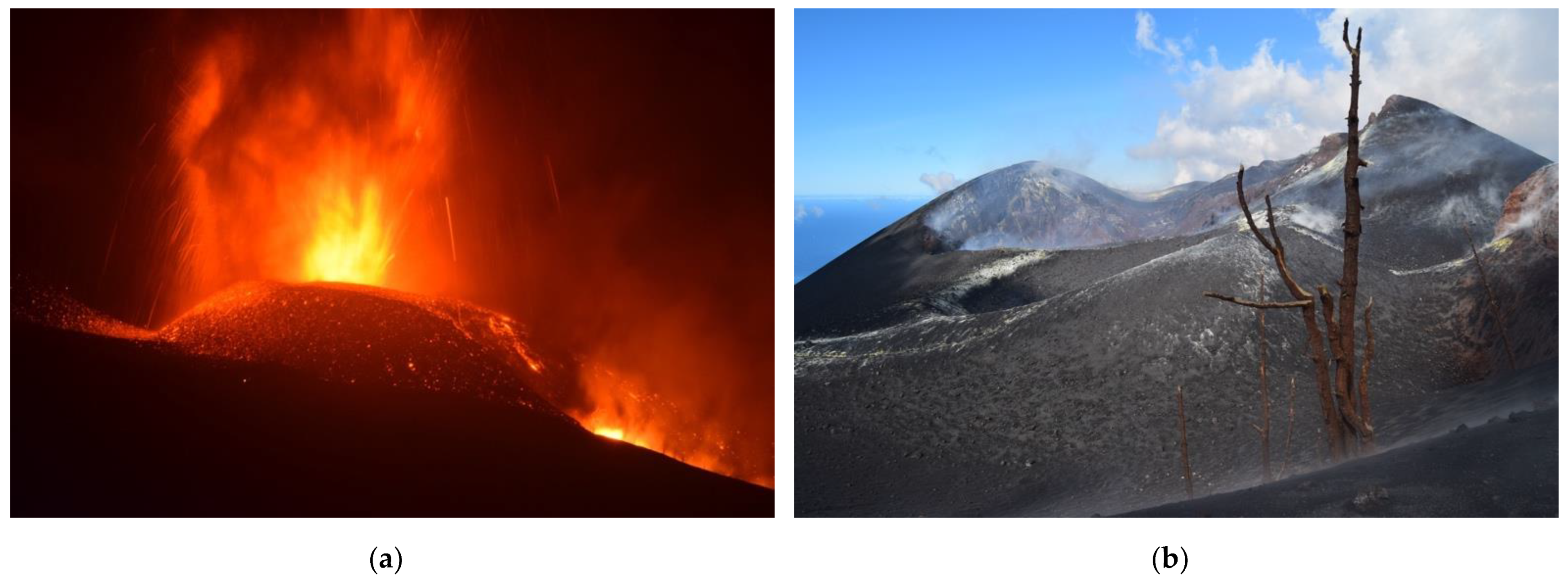
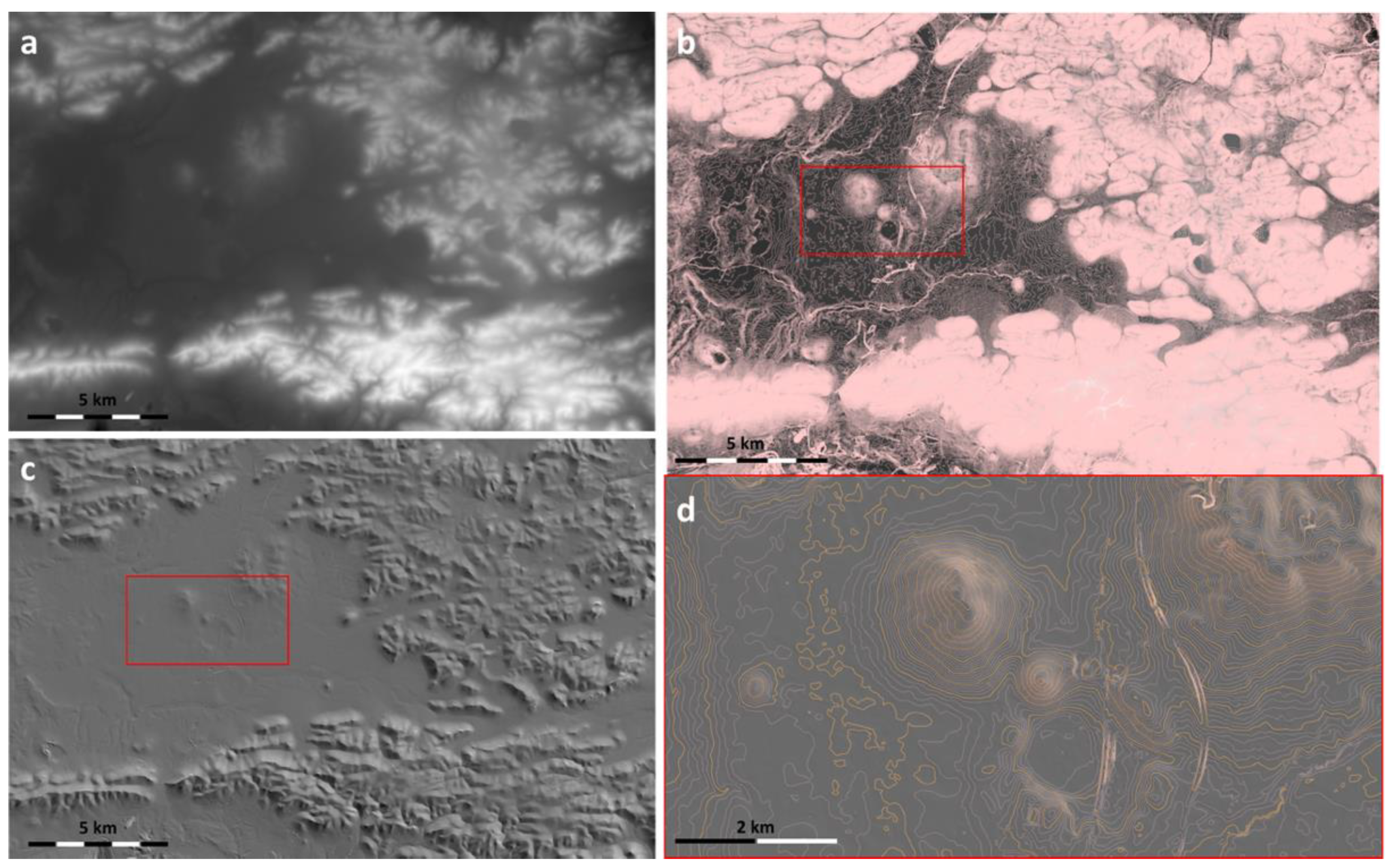
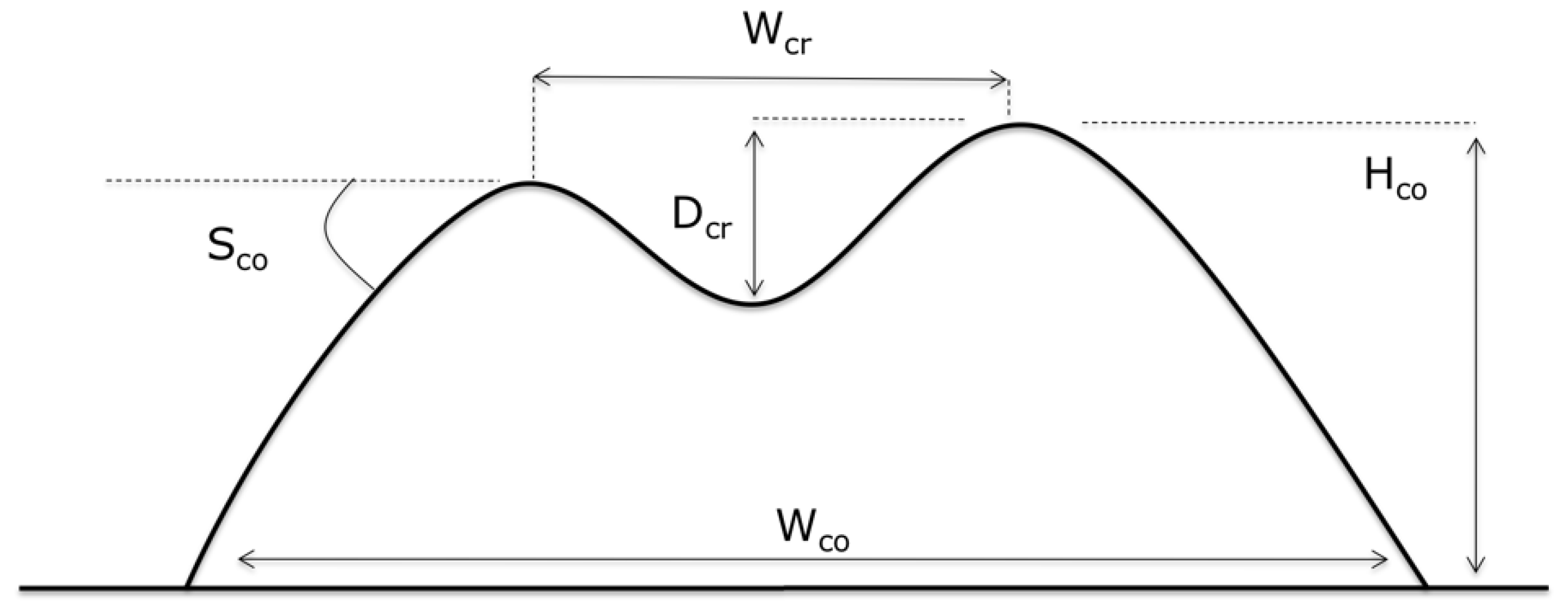

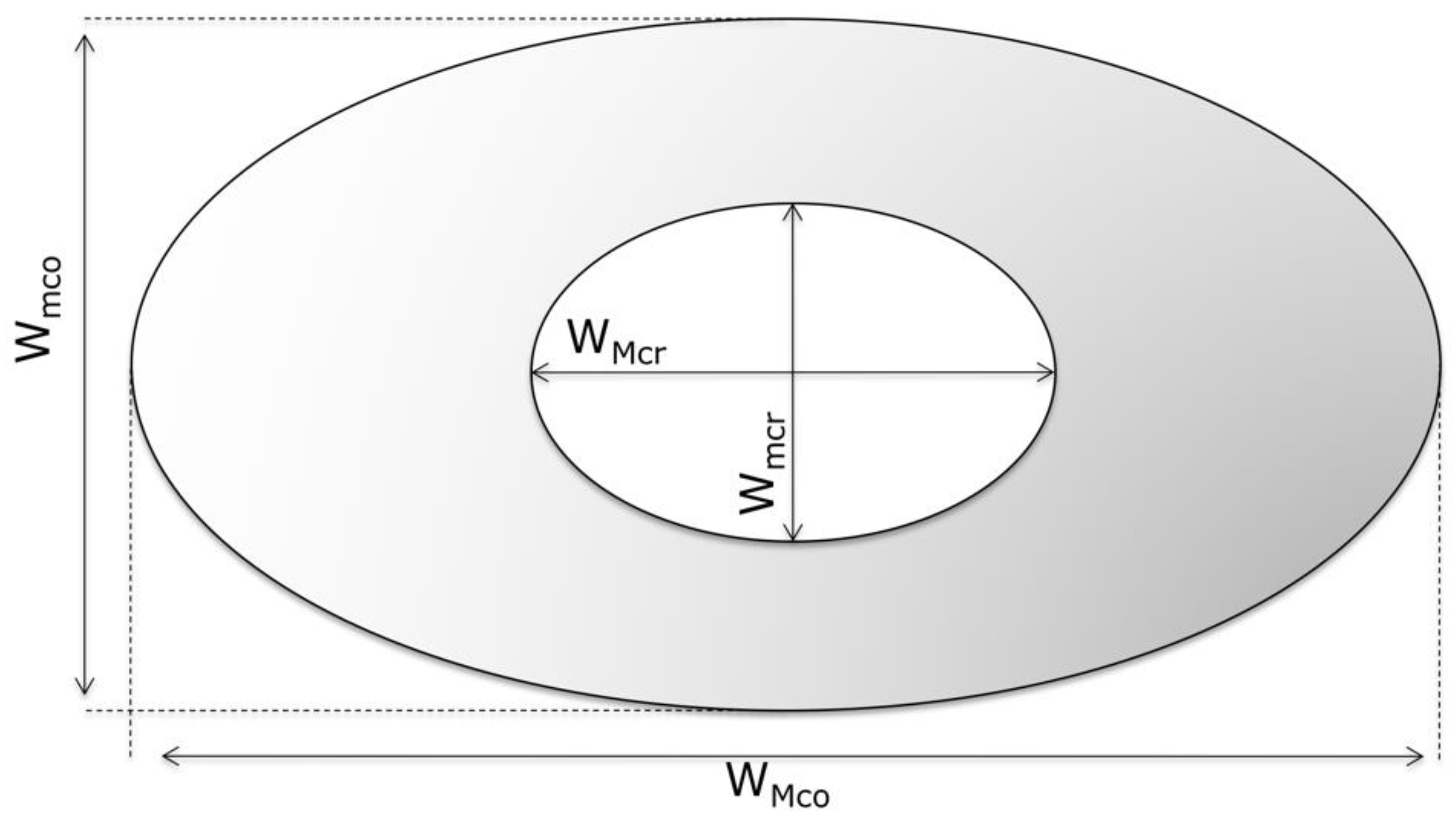

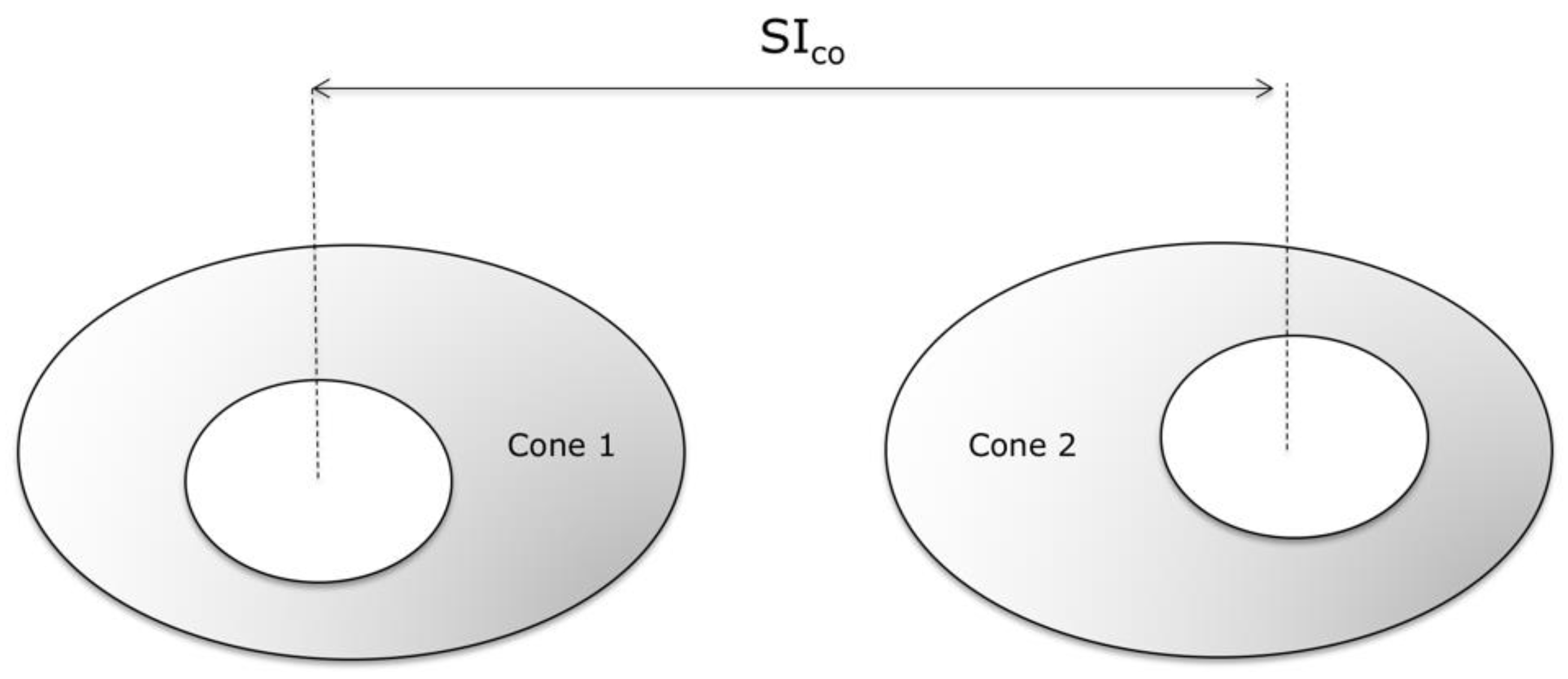
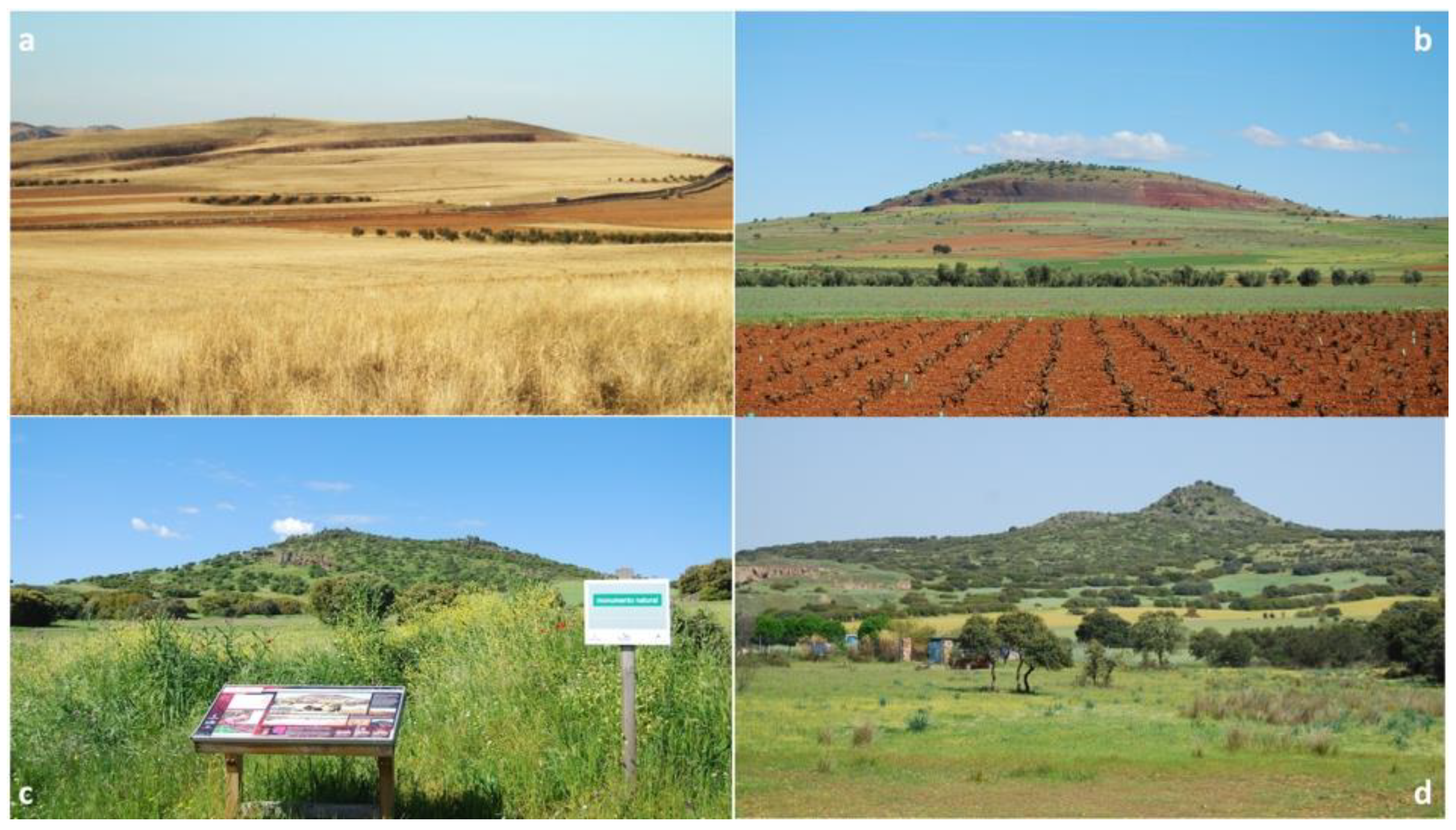
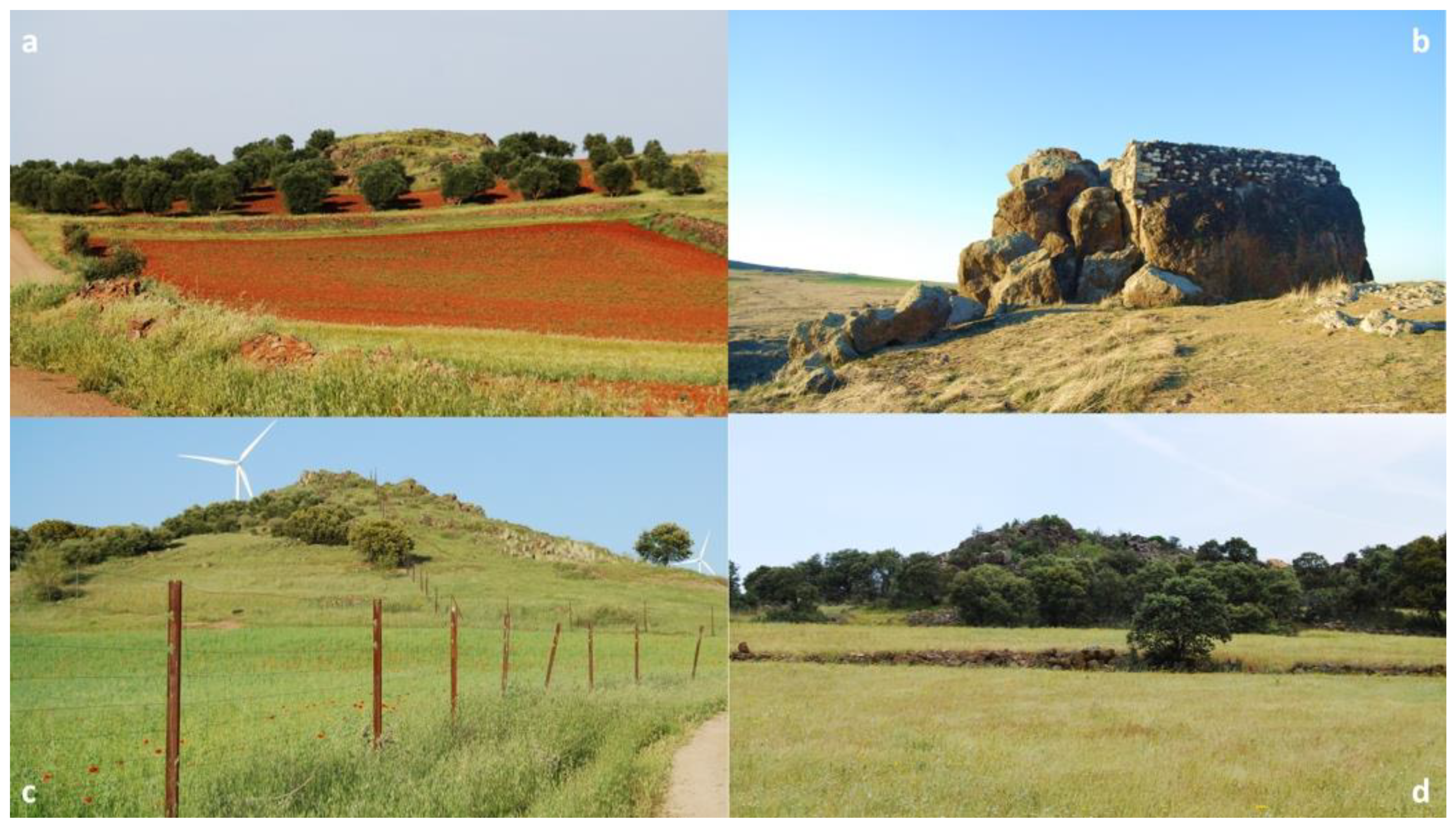
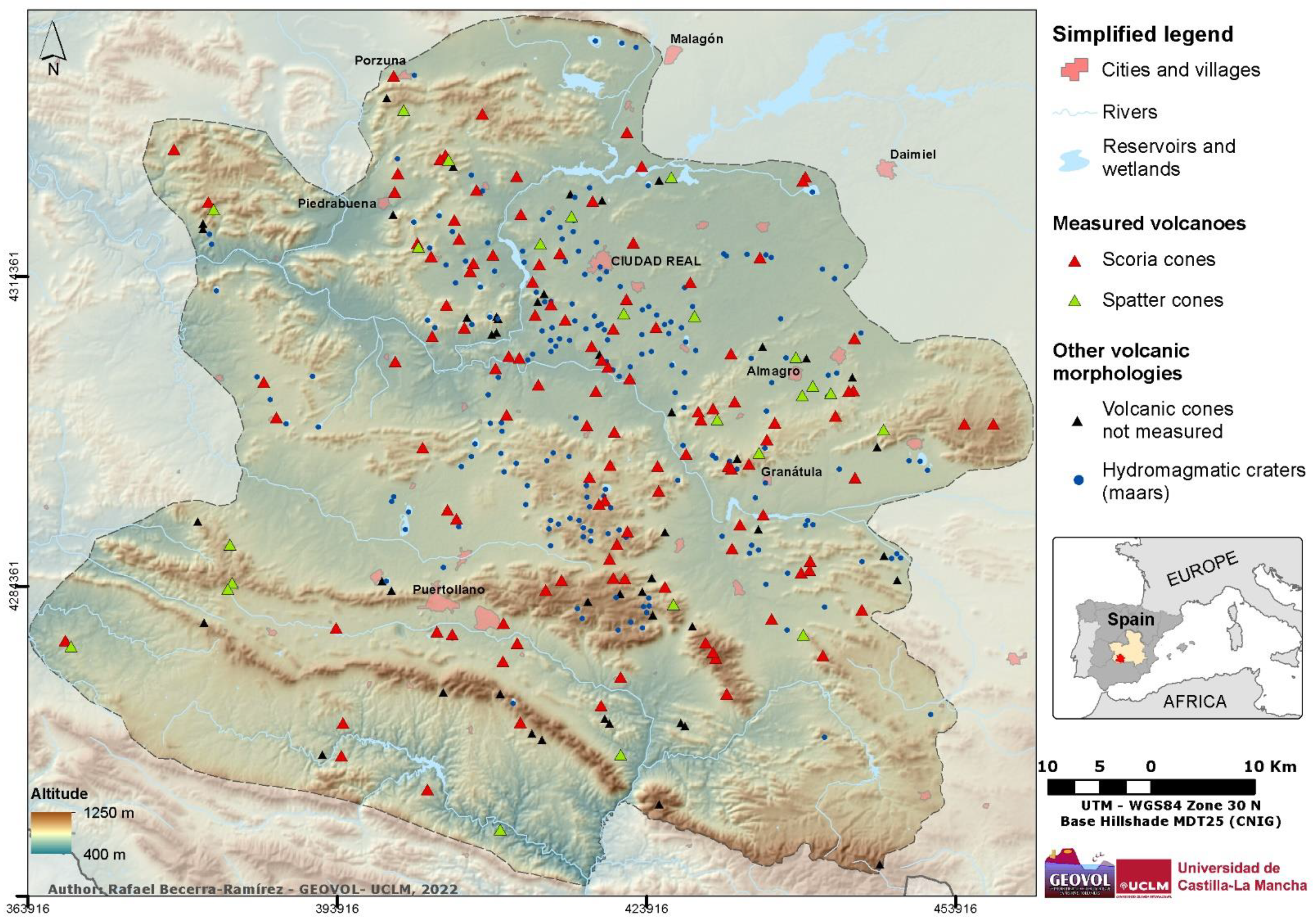


| Hco | Aco | Vco | WMco | Wmco | Wco | Ncr | WMcr | Wmcr | Wcr | Dcr | Smaxco | Sco | Eco | Ecr | SIco | |
|---|---|---|---|---|---|---|---|---|---|---|---|---|---|---|---|---|
| Hco | - | 0.42 | 0.76 | 0.45 | 0.47 | 0.47 | 0.40 | 0.53 | 0.48 | 0.52 | 0.59 | 0.58 | 0.54 | −0.19 | −0.01 | −0.08 |
| Aco | 0.42 | - | 0.80 | 0.93 | 0.96 | 0.96 | 0.09 | 0.52 | 0.56 | 0.55 | 0.12 | −0.16 | −0.31 | −0.38 | −0.18 | 0.02 |
| Vco | 0.76 | 0.80 | - | 0.77 | 0.80 | 0.79 | 0.21 | 0.72 | 0.73 | 0.74 | 0.46 | 0.15 | 0.05 | −0.33 | −0.11 | −0.06 |
| WMco | 0.45 | 0.93 | 0.77 | - | 0.96 | 0.99 | 0.14 | 0.49 | 0.54 | 0.52 | 0.13 | −0.19 | −0.37 | −0.27 | −0.22 | 0.03 |
| Wmco | 0.47 | 0.96 | 0.80 | 0.96 | - | 0.99 | 0.08 | 0.57 | 0.60 | 0.60 | 0.18 | −0.18 | −0.35 | −0.50 | −0.20 | 0.03 |
| Wco | 0.47 | 0.96 | 0.79 | 0.99 | 0.99 | - | 0.11 | 0.53 | 0.58 | 0.57 | 0.16 | −0.19 | −0.36 | −0.39 | −0.21 | 0.02 |
| Ncr | 0.40 | 0.09 | 0.21 | 0.14 | 0.08 | 0.11 | - | 0.12 | 0.06 | 0.10 | 0.12 | 0.27 | 0.23 | 0.15 | 0.16 | −0.16 |
| WMcr | 0.53 | 0.52 | 0.72 | 0.49 | 0.57 | 0.53 | 0.12 | - | 0.89 | 0.98 | 0.67 | 0.07 | −0.11 | −0.41 | 0.12 | 0.11 |
| Wmcr | 0.48 | 0.56 | 0.73 | 0.54 | 0.60 | 0.58 | 0.06 | 0.89 | - | 0.97 | 0.57 | 0.01 | −0.18 | −0.40 | −0.27 | 0.22 |
| Wcr | 0.52 | 0.55 | 0.74 | 0.52 | 0.60 | 0.57 | 0.10 | 0.98 | 0.97 | - | 0.64 | 0.04 | −0.14 | −0.42 | −0.05 | 0.16 |
| Dcr | 0.59 | 0.12 | 0.46 | 0.13 | 0.18 | 0.16 | 0.12 | 0.67 | 0.57 | 0.64 | - | 0.39 | 0.36 | −0.21 | 0.17 | −0.08 |
| Smaxco | 0.58 | −0.16 | 0.15 | −0.19 | −0.18 | −0.19 | 0.27 | 0.07 | 0.01 | 0..04 | 0.39 | - | 0.85 | 0.16 | 0.16 | 0.00 |
| Sco | 0.54 | −0.31 | 0.05 | −0.37 | −0.35 | −0.36 | 0.23 | −0.11 | −0.18 | −0.14 | 0.36 | 0.85 | - | 0.24 | 0.19 | −0.07 |
| Eco | −0.19 | −0.38 | −0.33 | −0.27 | −0.50 | −0.39 | 0.15 | −0.41 | −0.40 | −0.42 | −0.21 | 0.16 | 0.24 | - | 0.16 | 0.01 |
| Ecr | −0.01 | −0.18 | −0.11 | −0.22 | −0.20 | −0.21 | 0.16 | 0.12 | −0.27 | −0.05 | 0.17 | 0.16 | 0.19 | 0.16 | - | −0.22 |
| SIco | −0.08 | 0.02 | −0.06 | 0.03 | 0.02 | 0.02 | −0.16 | 0.11 | 0.22 | 0.16 | −0.08 | 0.00 | −0.07 | 0.01 | −0.22 | - |
| Components | ||||
|---|---|---|---|---|
| 1 | 2 | 3 | 4 | |
| Hco | 0.608 | 0.621 | 0.284 | −0.208 |
| Aco | 0.884 | −0.296 | 0.267 | 0.031 |
| Vco | 0.909 | 0.217 | 0.186 | −0.048 |
| WMco | 0.874 | −0.283 | 0.325 | −0.030 |
| Wmco | 0.928 | −0.258 | 0.202 | 0.007 |
| Wco | 0.912 | −0.274 | 0.268 | −0.012 |
| Ncr | 0.135 | 0.396 | 0.568 | 0.023 |
| WMcr | 0.806 | 0.345 | −0.347 | 0.240 |
| Wmcr | 0.833 | 0.209 | −0.385 | −0.102 |
| Wcr | 0.840 | 0.293 | −0.374 | 0.093 |
| Dcr | 0.444 | 0.690 | −0.308 | 0.120 |
| Smaxco | −0.167 | 0.828 | 0.047 | −0.291 |
| Sco | −0.341 | 0.840 | 0.139 | −0.219 |
| Eco | −0.532 | 0.163 | 0.315 | −0.051 |
| Ecr | −0.182 | 0.326 | 0.101 | 0.824 |
| SIco | 0.190 | −0.333 | −0.412 | −0.367 |
| Qualitative Attribute | Number of Cones | % of Total Cones |
|---|---|---|
| Morphology of the cones 1 | ||
| Ring-shaped cone | 17 | 14.91 |
| Horseshoe-shaped cone | 20 | 17.54 |
| Multiple cones | 10 | 8.77 |
| Cones without crater 2 | ||
| Ash-dominated cones Spatter-lavas dominated cones | 45 22 | 39.77 19.30 |
| Topographic emplacement | ||
| Plain or valley | 52 | 45.61 |
| Piedmont or hillside | 27 | 23.68 |
| Mountain 3 | 35 | 30.70 |
| Size of the cones 4 | ||
| Small cone | 83 | 72.81 |
| Medium cone | 8 | 7.02 |
| Others | 23 | 20.18 |
| Cone Parameters * | Modal Intervals | Number of Cones | % of Total Cones |
|---|---|---|---|
| Hco | 0 <50 m | 88 | 77.19 |
| Aco | <0.6 km2 | 86 | 75.44 |
| Vco | <0.01 km3 | 83 | 72.81 |
| WMco | ≥500 <1000 m | 63 | 55.26 |
| Wmco | <1000 m | 51 | 44.74 |
| Wco | ≥500 <1000 m | 51 | 44.74 |
| WMcr | ≥125 <250 m | 20 | 42.55 1 |
| Wmcr | 0 <250 m | 42 | 89.36 1 |
| Wcr | ≥25 <145 m | 20 | 42.55 1 |
Publisher’s Note: MDPI stays neutral with regard to jurisdictional claims in published maps and institutional affiliations. |
© 2022 by the authors. Licensee MDPI, Basel, Switzerland. This article is an open access article distributed under the terms and conditions of the Creative Commons Attribution (CC BY) license (https://creativecommons.org/licenses/by/4.0/).
Share and Cite
Becerra-Ramírez, R.; Dóniz-Páez, J.; González, E. Morphometric Analysis of Scoria Cones to Define the ‘Volcano-Type’ of the Campo de Calatrava Volcanic Region (Central Spain). Land 2022, 11, 917. https://doi.org/10.3390/land11060917
Becerra-Ramírez R, Dóniz-Páez J, González E. Morphometric Analysis of Scoria Cones to Define the ‘Volcano-Type’ of the Campo de Calatrava Volcanic Region (Central Spain). Land. 2022; 11(6):917. https://doi.org/10.3390/land11060917
Chicago/Turabian StyleBecerra-Ramírez, Rafael, Javier Dóniz-Páez, and Elena González. 2022. "Morphometric Analysis of Scoria Cones to Define the ‘Volcano-Type’ of the Campo de Calatrava Volcanic Region (Central Spain)" Land 11, no. 6: 917. https://doi.org/10.3390/land11060917
APA StyleBecerra-Ramírez, R., Dóniz-Páez, J., & González, E. (2022). Morphometric Analysis of Scoria Cones to Define the ‘Volcano-Type’ of the Campo de Calatrava Volcanic Region (Central Spain). Land, 11(6), 917. https://doi.org/10.3390/land11060917







